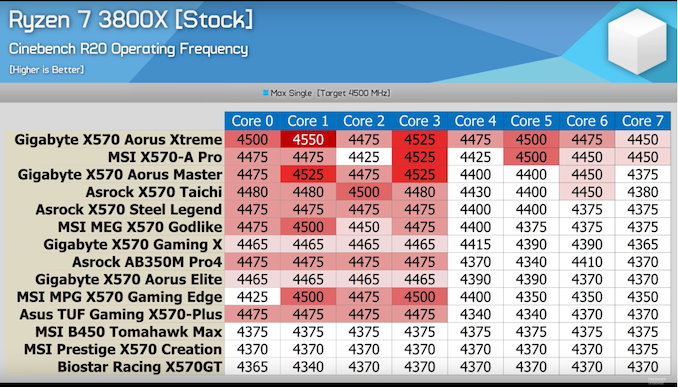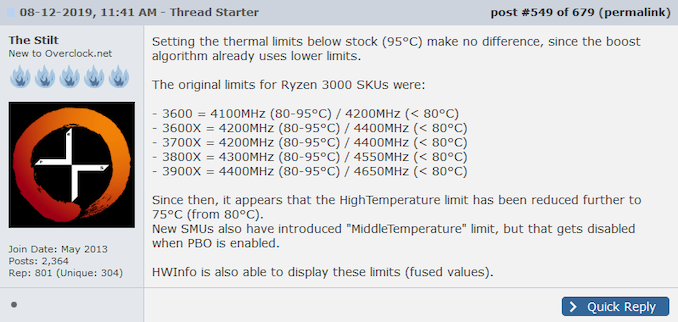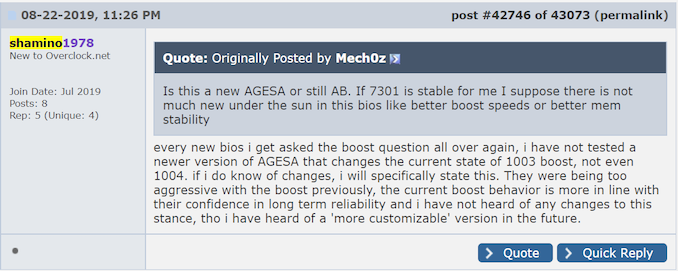Reaching for Turbo: Aligning Perception with AMD’s Frequency Metrics
by Dr. Ian Cutress on September 17, 2019 10:00 AM ESTAMD’s Turbo Issue (Abridged)
So why all this talk about how each company does its Turbo functionality, as well as its binning strategy? I prepped this story with the differences because a lot of our user base still thinks in terms of Intel’s way of doing things. Now that AMD is in the game and carving its own path, it’s important to understand AMD’s strategy in the context of the products coming out.
With that in mind, let’s cover AMD’s recent news.
Ever since the launch of Zen 2 and the Ryzen 3000 series CPUs, AMD has done its usual of advertising core counts, base frequency, TDP, and turbo frequencies. What has occurred since initial launch day reviews and through the public availability has been that groups of enthusiast users, looking to get the most out of their new shiny hardware, have reported that their processors are not hitting the turbo frequencies.
If a processor had a guaranteed 4.4 GHz turbo frequency, users were complaining that their peak turbo frequencies observed were 25-100 MHz less, or in some cases more than 100 MHz down on what was advertised. This kind of drop in frequency was being roughly reported through the ecosystem, but no-one particularly acted on it until these past few weeks, around the same time that AMD had several other news stories going on.
Multiple outlets, such as Hardware Unboxed, noted that the frequencies they were seeing significantly depended on the motherboard used. Hardware Unboxed tested 14 different AMD AM4 motherboards (some X570, others not X570) with a Ryzen 7 3800X, expecting a peak turbo frequency during Cinebench R20 of 4.5 GHz. Only one motherboard was consistent across most CPUs, while a few others were hit and miss.
This obviously plays into some reasoning that the turbo is motherboard dependent, all else being equal. It should be noted that there’s no guarantee that all these motherboards, despite being on the latest BIOSes, actually had AMD’s latest firmware versions in place.
Another outlet, Gamers Nexus, also observed that they could guarantee a CPU would hit its rated turbo speeds when the system was under some form of cold, either chilled water or a sub-zero cooling environment. This ultimately would lead some believe that this relates to a thermal capacity issue within the motherboard, CPU, or power delivery.
The Stilt, a popular user commonly associated with AMD’s hardware and its foibles, posted on 8/12 that AMD had reduced its peak temperature value for the Ryzen 3000 CPUs, and had introduced a middle temperature value to help guide the turbo. These values would be part of the SMU, or System Management Unit, that helps control turbo functionality.
Peter Tan, aka Shamino, a world renowned (retired) overclocker and senior engineer for ASUS’ motherboard division, acknowledged the issue in a forum post on 8/22 with his own take on the matter. He stated that AMD’s initial outlay with its turbo boost behavior was ultimately too aggressive, and in order to ensure longevity of the chip, the boost behavior was in line with what AMD needed to achieve that longevity.
It should be stated here that Shamino is speaking here in his personal capacity.
For those not engrained in the minutae of forum life, the biggest arrow to this issue came from Roman Hartung, or Der8auer, through his YouTube channel. He enlisted the help of his audience to tabulate what frequencies users were getting.
In the survey, the following details were requested:
- CPU
- Motherboard
- AGESA version/BIOS version
- PBO disabled
- Air cooling
Now obviously when it was announced that this survey was going to happen, Roman and AMD discussed behind the scenes the pros and cons about this survey. As you might expect, AMD had some reservations that this survey was in any way going to be fair – it’s about as unscientific as you can get. Naturally Roman argued that these would be real world results with users machines, rather than in-lab results, and AMD should be guaranteeing users on their home machines with specific frequency values. AMD also pointed out that with this sort of survey, you have an inherent selection bias: users who feel negatively impacted by any issue (through AMD’s fault or the users own) are more likely to respond than those that were happy with the performance. Roman agreed that this would be a concern, but still highlighted the fact that users shouldn’t be having these issues in the first place. AMD also mentioned that the Windows version couldn’t be controlled, to which Roman argued that if turbo is only valid for a certain Windows version, then it’s not fair to promote it, however did concede that the best performance was the latest version of Windows 10, and users on Windows 7 will have to accept some level of reduced performance.
Roman and AMD did at least agree on a testing scenario in order to standardize the reporting. Based on AMD’s recommendations, Roman requested from his audience that they use CineBench R15 as a single threaded load, and HWiNFO as the reporting tool, set to a 500 millisecond (0.5 second) polling interval, with the peak frequency from the CPU listed.
The survey ended up with ~3300 valid submissions, which Roman checked one-by-one to make sure all the data was present, screenshots showed the right values, and removed any data points that didn’t pass the testing conditions (such as PBO enabled). The results are explained in Roman’s video and the video is well worth a look. I’ve summarized the data for each CPU here.
| Der8auer's Ryzen Turbo Survey Results | |||||
| AnandTech | 3600 | 3600X | 3700X | 3800X | 3900X |
| Rated Turbo MHz of CPU | 4200 | 4400 | 4400 | 4500 | 4600 |
| Average Survey MHz | 4158 | 4320 | 4345 | 4450 | 4475 |
| Mode Survey MHz* | 4200 | 4350 | 4375 | 4475 | 4525 |
| Total Results Submitted | 568 | 190 | 1087 | 159 | 722 |
| # Results Minus Outliers | 542 | 180 | 1036 | 150 | 685 |
| Results >= Rated Turbo | 210 | 17 | 153 | 39 | 38 |
| % Results >= Rated Turbo | 50% | 9% | 15% | 26% | 6% |
| *Mode = most frequent result | |||||
I have corrected a couple of Roman’s calculations based on the video data, but they were minor changes.
For each CPU, we have the listed turbo frequency, the average turbo frequency from the survey, and the modal CPU frequency (i.e. the most frequently reported frequency). Beyond this, the number of users that reported a frequency equal to the turbo frequency or higher is listed as a percentage.
On the positive, the modal reported CPU frequency for almost all chips (except the 3900X) is relatively close, showing that most users are within 25-50 MHz of the advertised peak turbo frequency. The downside is that the actual number of users achieving the rated turbo is quite low. Aside from the Ryzen 5 3600, which is 50%, all the other CPUs struggle to see rated turbo speeds on the box.
As you might imagine, this data caused quite a stir in the community, and a number of vocal users who had invested hard earned money into their systems were agonizingly frustrated that they were not seeing the numbers that the box promised.
Before covering AMD’s response, I want to discuss frequency monitoring tools, turbo times, and the inherent issues with the Observer Effect. There’s also the issue of how long does turbo need to be active for it to count (or even register in software).













144 Comments
View All Comments
Korguz - Thursday, September 19, 2019 - link
so i guess you are ok with intel marketing their chips to only use the watts they state, but under real usage, they can, specially when overclocked, they can use MUCH more ??Cooe - Tuesday, March 23, 2021 - link
It doesn't say "4.7GHz Turbo" it says "Max 4.7GHz Turbo". Aka "UP TO!". It's not AMD's fault if "Average Joe" literally doesn't know how to read...Oliseo - Wednesday, September 18, 2019 - link
Also, if YOU have to write a multi page highly technical article on why AMD is right and all the customers are wrong, then you're just a fanboy who doesn't give a **** about the customer.We get enough of this in the comments with people in the media joining in to make excuses for large multinationals at the expense of the average consumer.
Shame on you!
eva02langley - Wednesday, September 18, 2019 - link
Here, these people will escort you to your new home, the asylum... cheers and enjoy you stray jacket...Calabros - Wednesday, September 18, 2019 - link
This the funniest First World Problem I've seen in 2019.regsEx - Wednesday, September 18, 2019 - link
I can't find any reference in CFL documentation that PL1 is for base clocks. It doesn't seem to have any correlation.edzieba - Wednesday, September 18, 2019 - link
Sounds like the "Intel Performance Maximizer" is exploring and characterising the frequency-space above the all-core turbo clock. That could be done at the factory to provide faster out-of-the-box performance, but would either introduce chip-to-chip variation is stock (rather than OC) performance, or create even more SKU bins. And people already throw a wobbler over he number of SKUs Intel produce (even though 90% of those are not a consideration unless you order direct from them in $multimillion batches).samboy - Wednesday, September 18, 2019 - link
My biggest concern is for the 3950x.This has the highest Turbo specification of all the processors; which was a good selling point when I first saw the specifications
However, it is becoming clear that the all-core base clock speed specification is more important. Particularly given that the 3900x seems to take the least "advantage" of Turbo out of all the current chips.
Comparing the specifications of 3950x to 3900x we see a 300MHZ drop off on base core speed; in exchange for an extra 100MHZ in boost - which seems somewhat questionable now.
A 50% increase in cost for an extra 4 cores and likely slower throughput for tasks that use 12 or less cores (which covers almost everything that is run in practice today) this doesn't look like particularly good value. My untested assumption is that the 300MHZ less in base speed is the more important number and will translate to slower throughput.
I'll wait for the reviews for the 3950x; but I expect that I'll be leaning for the 3900x for the second system I need to build.
oleyska - Wednesday, September 18, 2019 - link
3900X boosts higher than any other ryzen chip out today.I think 3950X will be faster than 3900X, on ryzen amount of cores doesn't matter at all.
Have a ryzen 1700? it isn't at all limited in comparison to a 1600 and on average seems to hit higher frequencies and it's absolutely true for 3000 series, even More so!
ajlueke - Thursday, September 19, 2019 - link
"A 50% increase in cost for an extra 4 cores and likely slower throughput for tasks that use 12 or less cores (which covers almost everything that is run in practice today) this doesn't look like particularly good value."The 3950X will almost certainly be faster than the 3900X in just about every scenario. If you consider the way the two chiplet CPUs are binned, they have one fast chiplet (CCD) and one that is not nearly as fast.
In the 3900X these CCDs are 6 cores each, while they are 8 cores in the 3950X. Which means in an 8 thread workload, the 3950X can do that entire workload on the "better" CCD0, which should have a better frequency/voltage curve. The 3900X will have to dip into 2 cores on CCD1. The 12 core workload is a similar story, the overall frequency/voltage curve will be better on the 3950X because it is boosting more "better" binned cores than the 3900X with the same power envelop.